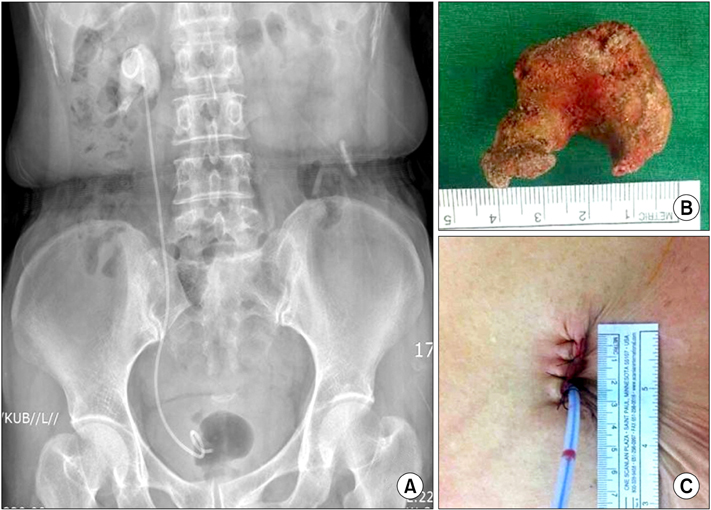Korean J Urol.
2013 Mar;54(3):163-167.
Laparoendoscopic Single-Site Pyelolithotomy With Use of a Carter-Thomason Needle Grasper
- Affiliations
-
- 1Department of Urology, Institute of Wonkwang Medical Science, Wonkwang University School of Medicine & Hospital, Iksan, Korea. seraph@wonkwang.ac.kr
Abstract
- PURPOSE
To study the feasibility and safety of the procedure, we present our early experience with laparoendoscopic single-site (LESS) pyelolithotomy performed by use of a Carter-Thomason needle grasper.
MATERIALS AND METHODS
Four patients underwent LESS pyelolithotomy for the removal of renal pelvic stones. The patients' mean age was 57.8 years, and their mean body mass index was 23.01. We used a homemade single-port device made with a surgical glove that was inserted into a 2.5-cm periumbilical incision. The operation was performed transperitoneally by using a Carter-Thomason grasper. After removal of the stone, a double-J stent was placed in situ, and laparoscopic intracorporeal suturing was performed. No additional ports were used.
RESULTS
All surgeries were completed successfully without conversion to conventional laparoscopy or open surgery. The mean operative time was 124.5 minutes, and the mean estimated blood loss was 255.2 mL. There were no significant complications, except in one patient who required a blood transfusion. The mean duration of hospital stay was 8.3 days. The mean stone size was 3.9 cm. Chemical analysis of the stones showed that three patients had calcium-containing stones and one patient had a uric acid stone. Postoperative radiologic study showed a stone clearance rate of 100%.
CONCLUSIONS
Our results, albeit limited, showed that LESS pyelolithotomy is a feasible and safe procedure. Especially with the use of a Carter-Thomason needle grasper, this operation can be performed without an additional port.
Keyword
MeSH Terms
Figure
Reference
-
1. Hruza M, Schulze M, Teber D, Gozen AS, Rassweiler JJ. Laparoscopic techniques for removal of renal and ureteral calculi. J Endourol. 2009. 23:1713–1718.2. Stein RJ, Turna B, Nguyen MM, Aron M, Hafron JM, Gill IS, et al. Laparoscopic pyeloplasty with concomitant pyelolithotomy: technique and outcomes. J Endourol. 2008. 22:1251–1255.3. Clayman RV, Kavoussi LR, Soper NJ, Dierks SM, Meretyk S, Darcy MD, et al. Laparoscopic nephrectomy: initial case report. J Urol. 1991. 146:278–282.4. Gill IS, Clayman RV, McDougall EM. Advances in urological laparoscopy. J Urol. 1995. 154:1275–1294.5. Gill IS, Canes D, Aron M, Haber GP, Goldfarb DA, Flechner S, et al. Single port transumbilical (E-NOTES) donor nephrectomy. J Urol. 2008. 180:637–641.6. Steinway ML, Lengu IJ, Cherullo EE, Ponsky LE. Laparoendoscopic single-site (LESS) nephrectomy through a Pfannenstiel incision: porcine model. J Endourol. 2009. 23:1293–1296.7. Hodgkinson A. A combined qualitative and quantitative procedure for the chemical analysis of urinary calculi. J Clin Pathol. 1971. 24:147–151.8. Lusuardi L, Janetschek G. Indications and outcomes of laparoscopic uretero-renal stone surgery. Curr Opin Urol. 2011. 21:161–165.9. Gaur DD, Agarwal DK, Purohit KC, Darshane AS. Retroperitoneal laparoscopic pyelolithotomy. J Urol. 1994. 151:927–929.10. Jordan GH, McCammon KA, Robey EL. Laparoscopic pyelolithotomy. Urology. 1997. 49:131–134.11. Kramer BA, Hammond L, Schwartz BF. Laparoscopic pyelolithotomy: indications and technique. J Endourol. 2007. 21:860–861.12. Goel A, Hemal AK. Evaluation of role of retroperitoneoscopic pyelolithotomy and its comparison with percutaneous nephrolithotripsy. Int Urol Nephrol. 2003. 35:73–76.13. Chander J, Gupta N, Lal P, Lal P, Ramteke VK. Retroperitoneal laparoscopic pyelolithotomy versus extra corporeal shock-wave lithotripsy for management of renal stones. J Minim Access Surg. 2010. 6:106–110.14. Raman JD, Bensalah K, Bagrodia A, Stern JM, Cadeddu JA. Laboratory and clinical development of single keyhole umbilical nephrectomy. Urology. 2007. 70:1039–1042.15. Gettman MT, Box G, Averch T, Cadeddu JA, Cherullo E, Clayman RV, et al. Consensus statement on natural orifice transluminal endoscopic surgery and single-incision laparoscopic surgery: heralding a new era in urology? Eur Urol. 2008. 53:1117–1120.16. Tracy CR, Raman JD, Cadeddu JA, Rane A. Laparoendoscopic single-site surgery in urology: where have we been and where are we heading? Nat Clin Pract Urol. 2008. 5:561–568.17. Choi KH, Yang SC, Lee JW, Rha KH, Han WK. Laparoendoscopic single-site surgery for ureterolithotomy: focus on intracorporeal stenting and suturing. Urology. 2010. 76:1283–1287.18. Wen X, Liu X, Huang H, Wu J, Huang W, Cai S, et al. Retroperitoneal laparoendoscopic single-site ureterolithotomy: a comparison with conventional laparoscopic surgery. J Endourol. 2012. 26:366–371.19. Park YH, Kang MY, Jeong MS, Choi H, Kim HH. Laparoendoscopic single-site nephrectomy using a homemade single-port device for single-system ectopic ureter in a child: initial case report. J Endourol. 2009. 23:833–835.20. Elashry OM, Nakada SY, Wolf JS Jr, Figenshau RS, McDougall EM, Clayman RV. Comparative clinical study of port-closure techniques following laparoscopic surgery. J Am Coll Surg. 1996. 183:335–344.
- Full Text Links
- Actions
-
Cited
- CITED
-
- Close
- Share
- Similar articles
-
- Convenience of Adding a Needle Grasper in Single-Incision Laparoscopic Distal Gastrectomy With Billroth I Anastomosis for Clinical Early Gastric Cancer
- Hybrid laparoscopic myomectomy: A novel technique
- Robot-assisted laparoendoscopic single-site upper urinary tract surgery with da Vinci Xi surgical system: Initial experience
- Clinical Observation of Extended Pyelolithotomy
- Clinical Experience of Extended Pyelolithotomy



